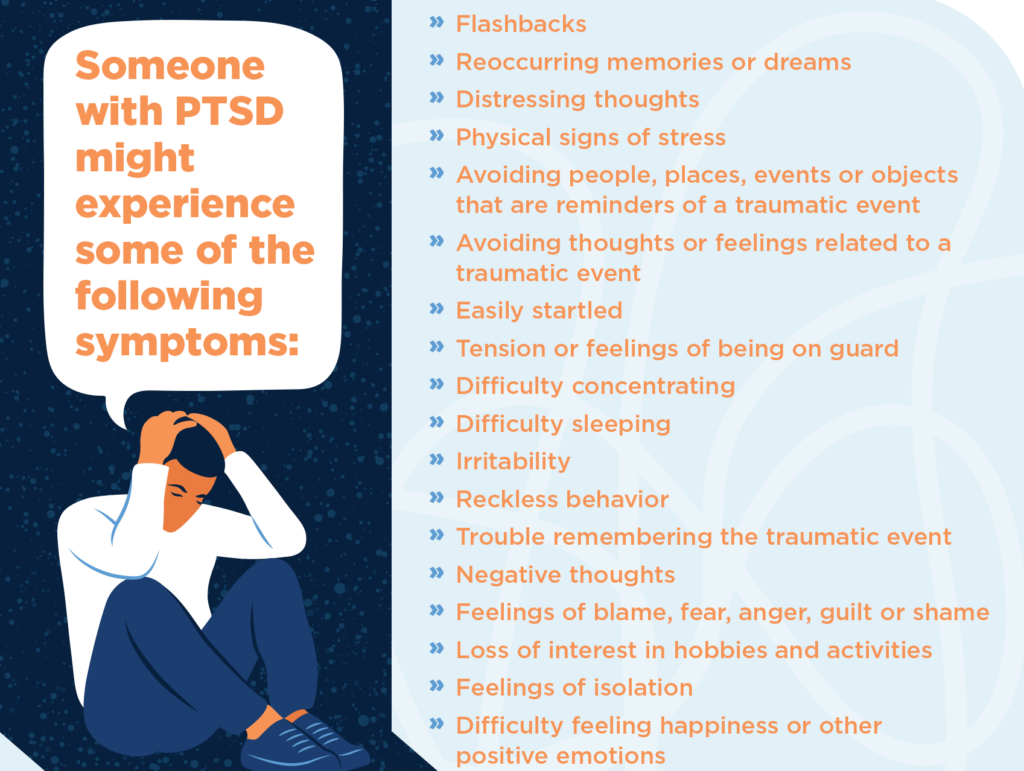The sounding of a siren. The scent of a cologne. The sight of a hospital hallway. For someone who has suffered a traumatic event, reminders as simple as these could cause flashbacks, just one of the symptoms of Posttraumatic Stress Disorder (PTSD).
According to the American Psychiatric Association (APA), PTSD can affect a person’s mental, physical and spiritual well-being and is “a psychiatric disorder than can occur in people who have experienced or witnessed a traumatic event, series of events or set of circumstances.”

It can be caused by a wide range of events, including natural disasters, combat, bullying, accidents and historical trauma. The National Institute for Mental Health (NIMH) also lists life events such as the death of a loved one as possible causes.
“An exposure to death or the threat of death or serious injury, sexual violence, those are all things that are associated with the diagnosis of PTSD,” Citizen Potawatomi Nation Behavioral Health Coordinator Virginia Kinkade said.
She listed hypervigilance, panic attacks, reoccurring nightmares and avoiding certain situations that are reminders of a trauma experience as symptoms of PTSD.
PTSD and Native populations
The APA explains that PTSD, which many people associate with veterans, affects people of all ethnicities, nationalities and ages.
The Native population in the U.S. suffers the highest rates of PTSD, along with Latino and African American populations. NIMH cited a study that estimates 4.8 to 6.4% of the general U.S. population will develop PTSD, which increases to 16 to 24% for Native Americans and Alaskan Natives.
“Women’s diagnosis is much higher than men,” Kinkade said. “But for Native women, it’s exceptionally high.”
She said there are also many reasons Indigenous women are sometimes apprehensive about seeking help.
“I think that historical trauma definitely plays a role in that,” she said.
Women might have been raised by generations of women forced to attend boarding schools and conditioned not to talk, separated from family and separated from their language.
“That has an impact still. … It’s been one of my greatest privileges to work with Native women, develop trusting therapeutic relationships and witness recovery. The resilience is just amazing to witness,” Kinkade said.
“My hope is that the women who have transitioned from surviving trauma to thriving in trauma recovery as a result of trauma treatment will share and encourage others to seek treatment with us. And that is already happening. We are having more women come in to address trauma. I hope it continues.”
Domestic violence and PTSD
Prevention and Education Coordinator Kayla Woody, with Citizen Potawatomi Nation’s House of Hope, said survivors of domestic violence, sexual violence and stalking are just some of those who might suffer from the effects of PTSD. Sometimes, she said, triggers come from unexpected sources like smells, sounds or even textures.
“We’ve even had survivors walk into a store and see someone that has the same type of characteristic as their perpetrator and then shut down in that store. Or smell a type of cologne or a scent that reminds them of a certain situation they were in,” Woody said.
She also explained that PTSD can affect not only the victim but also witnesses, family members, first responders, or even social workers who help survivors.
“It’s important to understand that PTSD won’t just happen to the victim of the trauma,” Woody said. “It could be for the child who witnessed it, for the advocate who’s trying to provide assistance, or the family members.”
However, Woody also explained that not everyone who experiences trauma will necessarily develop PTSD, and those who do manifest their symptoms in different ways.
“It may make it difficult for an individual to see they might have PTSD because they’re not experiencing the same things as another person (with PTSD),” Woody said. “But everyone is very different in how they process that trauma.”
Seeking help
For those potentially suffering from PTSD, Kinkade said Behavioral Health offers a variety of services and different types of therapy, either with clinicians or with a psychiatrist on staff.
“One of the things that’s really exciting right now is that we’re exploring treatment approaches that are more culturally meaningful,” Kinkade said. “There’s some evidence that indicates treatments that don’t require as much talk therapy have good outcomes with Native American clients.”
For example, Behavioral Health offers a women’s trauma group that communicates about their feelings while doing cultural activities such as beading.
“Seeking treatment can make all the difference in long-term quality of life. Untreated trauma can manifest in a number of ways,” Kinkade said, listing depression, anxiety, and negative impact on relationships and employment as just some ways it might manifest. “Every aspect of life can be impacted by trauma that goes untreated.”
Tribal members who are survivors of domestic violence, sexual violence and stalking, or who think they may be suffering PTSD, can contact House of Hope at 405-275-3176.
Tribal members who may be suffering from PTSD can also call Behavioral Health at 405-214-5101. An intake clerk will help callers fill out an application and establish services. No referral is necessary for Tribal members and CPN employees. For Tribal members who do not live in the Shawnee, Oklahoma, area, Kinkade said Behavioral Health can still act as a point of contact to help find assistance.
